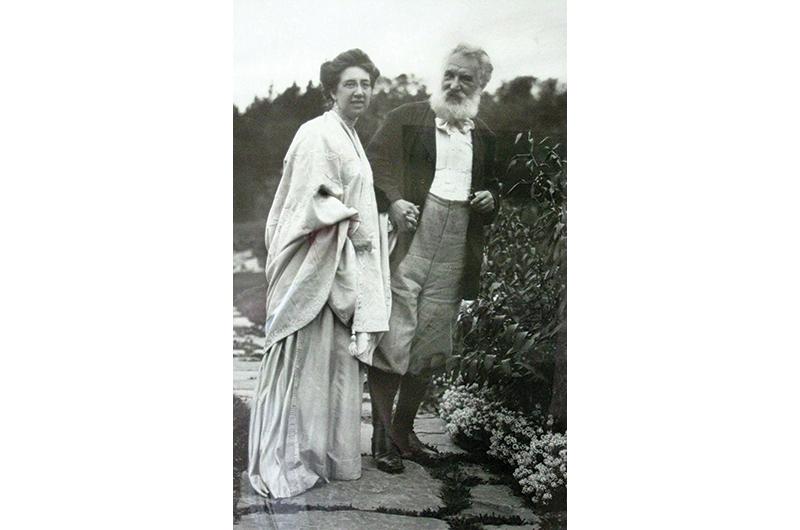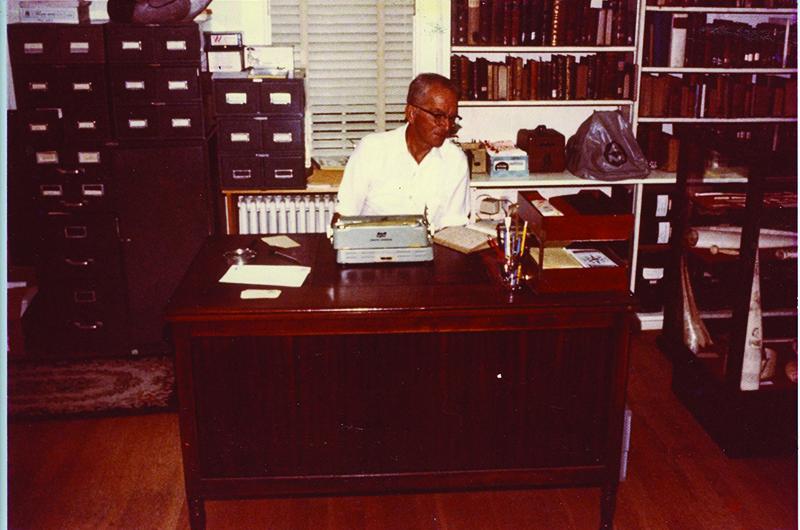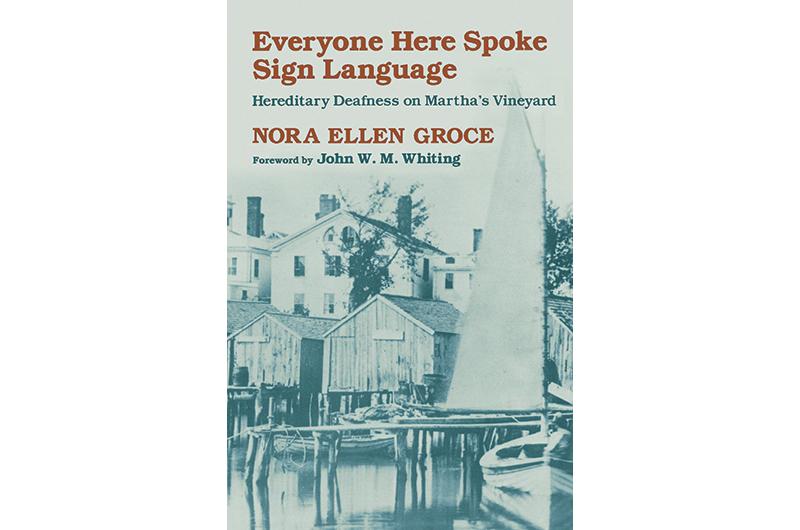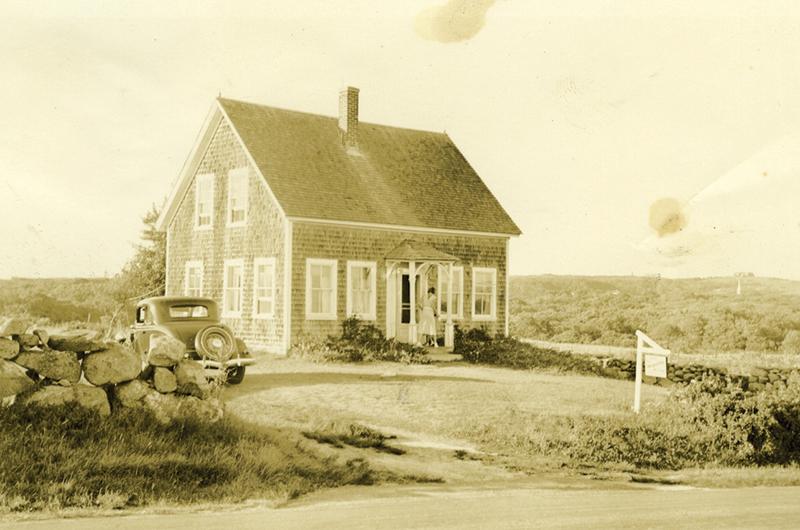On December 2, 1885, Alexander Graham Bell boarded a steamer from New Bedford to Vineyard Haven. With miles of abandoned cottages set against a howling storm, the area seemed a bit “cheerless,” he wrote in a letter. It was the type of setting he found conducive to work, however, which is what he had come to do. Not on his famous invention: he had founded the Bell Telephone Company nearly a decade before and was immensely rich because of it. He came to the Vineyard instead hoping for a breakthrough in what had been his great passion long before he became sidetracked by inventing the age of modern communications. He came to study deafness.
It was a subject that held more than academic interest to Bell. His mother, an accomplished pianist, suffered a childhood infection that left her mostly deaf. She kept playing music primarily by feeling it. At their church, Bell would press his lips to her temple, echoing the sermon in the deep, resonant tones that she could still grasp. Bell’s father, a renowned elocutionist, spent years developing a phonetic alphabet. He often cataloged sounds in his office until the early hours of the morning – Bell would find him perched in front of the mirror, reciting a lone syllable before pausing to diagram his mouth. From early on in life, then, Bell was a student of the human voice – and its absence.
By the age of twenty-one, in the year 1868, he had begun teaching the deaf. A short while later, Bell would encounter a teenaged student named Mabel Hubbard. A decade earlier, Hubbard had been overcome with fatigue on a train to New York. Within a week, her tongue became brown and stiff, and soon the infection had eaten away at her inner ear. When her fever finally broke, she sat up in her parents’ home and looked at them uncomprehendingly. “Why won’t you talk to me?” she supposedly pled.
Bell began to work with Hubbard in the fall, and by winter, her articulation had been utterly transformed. Their hours together stretched into years. “This work was intensely personal, work of bodies and vulnerability and trust,” Katie Booth wrote in The Invention of Miracles (Simon & Schuster, 2021). “But when it came to Mabel, [Bell] increasingly felt like this was the wrong position for him. In her touch he felt something more.” In 1877, they were married.
It was in those moments that Bell’s view of deafness began to shift. “Since there is in the deaf-mute no other natural defect than that of hearing,” he said during a speech at an American Instructors of the Deaf convention, “it is certainly possible to render him like hearing people in every other respect.” If the deaf could speak, Bell thought, they could shed their identities and blend imperceptibly into the mainstream. In a sense, they wouldn’t have to be deaf.

At the time, American deaf education was rooted in sign language, also known as manualism. The nineteenth century was widely considered to be the golden age of sign. But Bell saw sign language as a highly problematic methodology that prevented the deaf from joining society. Relying solely on their hands, he believed, they would be incapable of engaging with the hearing. He advocated teaching the deaf to read lips and speak words.
The public was astonished with his results. Rumors of Bell’s method, known as oralism, spread around New England and beyond. He traveled the country offering demonstrations. When he paid a visit to the American Asylum for the Deaf and Dumb in Hartford, Connecticut – the citadel of American Sign Language, a place where Hubbard’s own father was told she would never speak – Bell stood in front of 250 deaf students. With the sway of a conductor, he had them roar a single syllable so loud that the windows rattled. It was reportedly heard a quarter of a mile away.
During his travels, Bell also became consumed with understanding how deafness was passed down from generation to generation. He pored over records from New England’s deaf schools. According to author Booth, Bell noticed the same surnames showing up at the schools generation after generation. With his assistants, he launched a sweeping investigation into why a quality like deafness was transmitted down the generations – how, in a sense, the past quietly gives expression to the present.
Those early findings inevitably drew his attention to Martha’s Vineyard. The Island, and Chilmark in particular, was known among those interested in the education of the deaf as a place with an unusually large population of hearing-impaired residents. The first trace of a profound form of deafness surfaced on the Island in the late 1600s. By the end of the following century, its rate had climbed to four times the national average. In the 1840s, forty-five deaf children were reported to have been born in the span of a single decade. If the census data at the time is to believed, that would have put the average rate of deafness on the Vineyard at something like thirty-six times that of the national population.
If Bell was going to unravel the mystery of deafness, in other words, there was no better place to look than the Island.
When Bell arrived on the Vineyard, he found the historical records to be in bleak shape. “The words near the edges of the pages have been almost rubbed out by the licked thumbs of town-clerks applied during nearly two centuries,” he wrote in a letter to Hubbard. He was also staggered by the sheer volume of it. Nonetheless, he readied himself to transcribe the material by hand and preserve it for future analysis.

He made better progress after a chance meeting with an irrepressible local genealogist named Richard Pease, who had already spent years scribbling the genealogies of the entire local population on thousands of slips of paper. These he’d eventually sorted into little, individual muslin bags, including one for each family with a trace of deafness in its lineage. “Why I’ve found a mine [of information] in Mr. Pease!” Bell said. He feverishly arranged the data into elaborate charts, copying 206 pages in just four days.
The work consumed Bell, occupying much of the next four years of his life. When he wasn’t hunched over his notebooks, he roamed the Island. In a letter to Hubbard, it became clear that his impression of the place had softened. “These oak forests are intersected with romantic little roads,” he wrote to her, his fingers stiff and numb from overwork. “Even in December, there is a silent beauty in the woodland paths.”
And yet, unable to draw any firm conclusions about the sources of hereditary deafness, Bell ultimately abandoned the effort in a fit of despair. Instead, he began poring over procreation data relating to families with a high incidence of deafness. Already invested in the idea that the deaf could learn to speak and integrate into society, he was troubled by the tendency of some deaf people to primarily interact with one another. More alarming to Bell, he believed that deaf people were also having more children than those with hearing. He warned the trend could create a separate “race” of deaf humans.
With this new, vaguely eugenic fear – Bell was not immune to the “scientific racism” theories popular at the time – he amplified his efforts to replace sign language with oralism, believing that doing so would better integrate deaf people into society and reduce the number of deaf marriages. As Booth put it, “Doing so would dismantle the community that kept deaf people together.”
Having placed the considerable weight of his fame and authority behind the shift away from sign language, oralism eventually became the new standard. In 1868, when he first began teaching his approach, the manualist model was used in twenty-seven schools across the United States. By 1918, the number of manualist schools had shrunk to just two. By then, 80 percent of deaf students were being taught orally. It would remain the dominant method of teaching until the 1970s.
The problem was, Bell’s notion that all or even the vast majority of deaf people could successfully learn to read lips and speak orally turned out to be entirely unfounded. The oralist experiment in deaf education was an absolute, unmitigated failure that succeeded only in causing several generations of deaf children to come of age in an environment in which they were denied their own language.

Bell never published his raw data from the Vineyard. He did, however, make three copies of it. The first was incinerated when his assistant’s house burned down. The second was sacrificed to the archival bowels of the state historical society. And, nearly a century later, a twenty-six-year-old graduate student exhumed the third from a warehouse in Virginia.
In late October of 1978, Nora Ellen Groce, a doctoral student in anthropology at Brown University, was touring the Vineyard with a guide named Gale Huntington, a librarian and archivist at the Martha’s Vineyard Museum. Driving through Chilmark, they passed by one house – then another – where the owner, Huntington said, had been born deaf.
This struck Groce as odd. At the time, Chilmark had a little more than 400 residents. Groce was not yet aware that the incidence of hereditary deafness was only about one in 5,700 nationwide. But she asked Huntington if he knew of any other deaf locals. “Oh,” he replied, “I can remember six right offhand, no, seven.”
One drizzly afternoon, Groce interviewed Huntington at his home in Vineyard Haven. “[He] sat in his living room,” she later wrote in her dissertation – the frequently cited book Everyone Here Spoke Sign Language: Hereditary Deafness on Martha’s Vineyard (Harvard University Press, 1985) – “smoking a few of those cigarettes expressly forbidden by his doctor and taking more than a few sips of his favorite New England rum.” He began to share memories of his deaf neighbors. Almost as an afterthought, Groce asked how they communicated – by writing everything down?
“No,” he replied. “You see, everyone here spoke sign language.”
“You mean, the deaf people’s families and such?”

“Sure,” he said, walking into the kitchen to hunt down matches, “and everybody else in town too – I used to speak it, my mother did, everybody.”
Over the next four years, Groce conducted her research on the Island. During the first two, she had no knowledge that the famous inventor of the telephone had done similarly almost a century before. She combed through federal censuses and pored over birth, marriage, and death certificates, land deeds, tax rolls, ships’ logs, and private diaries. One chilly day, she spoke to an elderly local who was puzzled that visitors still asked about the deaf. This caught her attention. Had others visited?
“Well,” the woman said, “like that professor from Boston.” He’d asked her mother about the deaf many decades ago. “‘There was nothing at all unusual about them, you know,’” she recalled her mother saying.
After identifying her distant counterpart, Groce paid a visit to the John Hitz Memorial Library in Washington, D.C., where they had no record of Bell’s data. But Salome Swaim, a new librarian, was indexing their collections. “Less than a week before, she had found, in storage in a warehouse in Virginia, two large cardboard boxes containing all of [the] missing notes,” Groce wrote.
Armed with Bell’s trove, Groce posited that the recessive gene for hereditary deafness came to the Island via the family of Johnathan Lumbert/Lambert, the namesake of Lambert’s Cove. As decades passed, lines of descent became inextricably tangled. By the nineteenth century, the Island’s white colonist families consisted of only thirty-two last names. As marriage patterns continued in this restricted gene pool, “the chances of being born deaf,” Groce wrote, “rose with every generation.”
Groce took pains to map out the genealogy precisely. “I was then able to go back through all the Island’s written records, few of which Bell had used, and gather a substantial amount of data on the daily lives of deaf people,” she explained. She then tracked down more than two hundred living residents, many in their autumnal years. One by one, her elderly informants revealed a portrait of a community that was virtually a looking-glass version of the dystopian picture that Bell had previously painted in which deaf persons would be entirely cut off from society.

In Groce’s portrait of the Island, the deaf began to gesture with one another. They created a full-fledged language, now referred to as Martha’s Vineyard Sign Language, at first negotiating meaning out of certain gestures, then eventually developing a whole system from those flickers of exchange. The difference between everything Groce had seen and what Bell imagined was that, in Chilmark, the hearing spoke sign too. They typically learned in childhood, with fluctuating degrees of fluency. “It came naturally,” one woman told Groce, just as instinctively as she’d learned spoken English. Another man reported that his hearing cousin learned to sign with her deaf father before she could speak with her hearing mother.
In town meetings, a signer would stand in front and translate the proceedings for his fellow citizens. At church services, the wife of one deaf man would sit next to him in the pew and interpret the sermon. On front porches, the deaf would play checkers at night, in the flicker of a kerosene lamp, while silent conversation passed between them. It flourished in the wordless tales shared among children and in the casual banter at the local grocery store. “Of course, sometimes, if there were more deaf than hearing there, everyone would speak sign language – just to be polite, you know,” one man recalled.
In fact, the hearing even signed among themselves. It was used between students from desk to desk. It was used between fishermen from boat to shore. If a lady walked into the general store and a few locals were telling a risqué story, they’d turn and deliver the punchline in sign.
In this context, deafness ceased to be a disability. It was merely a difference. Most of the deaf had careers and eventually settled down to marry and have kids. Several held office and joined the local militia. They attended church services and town meetings and county fairs. They played cards outside the general store, and hosted chowder suppers and plum porridge parties inside their homes. They were integrated into every measure of the Island’s daily rhythms. In fact, they were rarely even set apart as such. When Groce asked Emily Howland Poole, then in her nineties, about her disabled neighbors, Poole was emphatic. “Oh,” she said, “those people weren’t handicapped. They were just deaf.”
Over the course of the twentieth century, Martha’s Vineyard had become far less insular than it once was. As a result, the Island’s limited gene pool became diluted, the community it helped create dwindled, and the once-ubiquitous Martha’s Vineyard Sign Language slowly began to fade away. By the time Groce began conducting her research, the last deaf signer on the Island had been dead for a quarter of a century.
Even so, an intimate circle of hearing signers had kept the remaining vestiges of their unique language alive. In the mid-1980s, after Groce’s dissertation was published, the neurologist and author Oliver Sacks leapt into his car the moment he finished reading it. With nothing more than a toothbrush, a tape recorder, and a camera, he drove to the Vineyard to see if he could find any remnants of the language itself.

“My first sight of this, indeed, was quite unforgettable,” Sacks wrote. “I drove up to the old general store in West Tisbury on a Sunday morning and saw half a dozen old people gossiping together on the porch. They could have been any old folks, old neighbors, talking together – until suddenly, very startlingly, they all dropped into Sign. They signed for a minute, laughed, then dropped back into speech. At this moment I knew I had come to the right place.”
Ultimately, however, it is Groce who has preserved this lesson in human understanding for future generations. In 2006, she presented to the United Nations during its drafting of the Convention on the Rights of Persons with Disabilities. She cited Chilmark as a model of inclusivity. The United States signed the international treaty but has yet to ratify it.
Groce, now a medical anthropologist at University College London, concluded her dissertation by noting that the perceived bounds of normalcy are not set in stone.
A disability is defined by the community in which it appears. “And if it is a question of definition,” she has said, “perhaps it can be redefined?”
“When you think about it, the Island was an awfully nice place to live,” one woman told Groce toward the end of her research.
“Indeed it was,” Groce concluded.




 2 comments
2 comments
Comments (2)